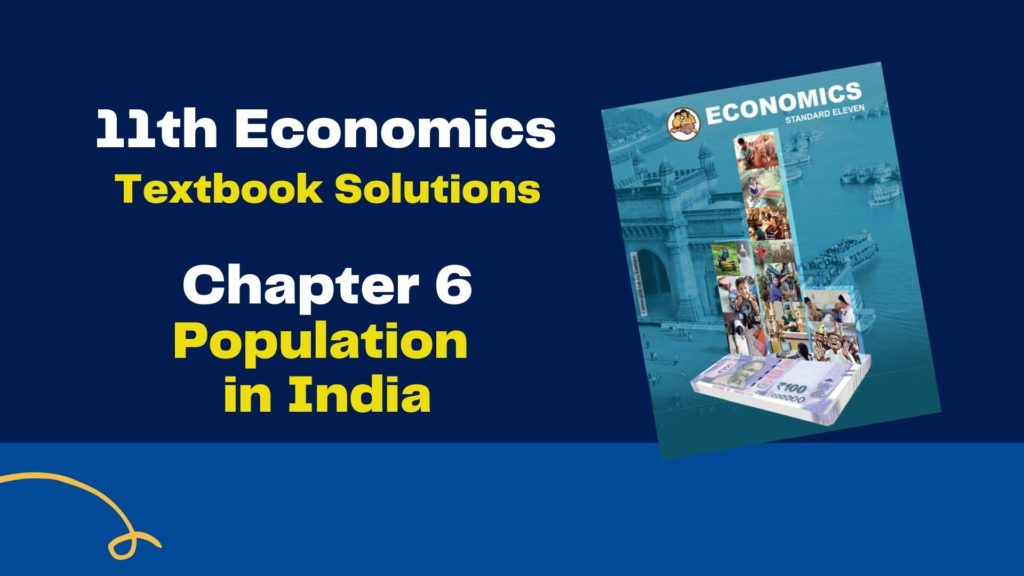11th Economics Chapter 6 Exercise Solution (Population in India) Maharashtra Board – Free Solution
Table of Contents
11th Economics Chapter 6 Exercise

Chapter 6 – Population in India
Q. 1. Choose the correct option
1) Stages of the theory of demographic transition.
a) High birth rate and high death rate
b) High birth rate and low death rate
c) Low birth rate and low death rate
d) Economic development
Options:
1) a and b
2) a and c
3) a, b and c
4) a, b, c and d
2) Incorrect reasons for population explosion in India.
a) Illiteracy
b) Universalization of Marriage
c) Joint family system
d) Upliftment in lifestyle
Options:
1) a and b
2) c and d
3) a, b and c
4) d
3) Remedies undertaken to check population explosion.
a) To provide employment
b) To improve women’s quality of life
c) National Population Policy
d) Disaster management
Options:
1) d
2) a and c
3) c and d
4) a, b and c
4) Choose the correct option.
| Group A | Group B |
| 1) Year of Great Divide | a) Stable population till 2045 |
| 2) A. J. Coale and E. M. Hoover | b) 1921 |
| 3) Social Reforms | c) Demographic Transition |
| d) Education Policy, 2000 | d) Spread of education |
Options:
1) 1-d, 2-c, 3-a, 4-b
2) 1-b, 2-c, 3-d, 4-a
3) 1-b, 2-a, 3-c, 4-d
4) 1-c, 2-d, 3-a, 4-b
Q. 2. Give economic terms
1) Increase in population is faster than economic growth and development.
Answer: Population explosion
2) Difference between birth rate and death rate.
Answer: Survival rate
3) Balance between natural resources and population growth.
Answer: Optimum population
4) Programme introduced to reduce the birth rate in 1952.
Answer: Family Planning Programme
Q. 3. Identify and explain the concepts from the given illustrations
1) There were 40 births per 1000 in country ‘A’ during a year.
Concept: Birth rate
Explanation: Birth rate means the number of births occurring per thousand of the living population during a year. It is also known as fertility rate.
2) In Mumbai city, public transport service is largely affected due to the growing population.
Concept: High Density of Population
Explanation: The number of people living per square kilometer is known as the density of population.
In India, it is 382 people per square kilometer as per the 2011 Census which is very high.
3) In country ‘B’, there are 15 deaths taking place per 1000 during a year.
Concept: Death rate
Explanation: The number of deaths per thousand of the living population during a year is called death rate. It is also called mortality rate.
4) For a certain period of time China had adopted the policy of ‘One child per family.
Concept: Population Policy
Explanation: China’s ‘One Child Policy’ was a part of a birth planning program designed to control the size of its population.
Solution of other subjects
Solution of all Chapters of Economics
1 – 2– 3 – 4 – 5 – 6 – 7 – 8 – 9 – 10
Q. 4. Answer the following
1) Explain the causes of high birth rate.
Answer: Birth rate means the number of births occurring per thousand of the living population during a year. It is also known as fertility rate.
Causes of high birth rate
1) Illiteracy:
The percentage of illiterates in the country is reasonably high. The attitude of illiterate people towards marriage and child birth has remained rigid. A low level of literacy among females is also responsible for a high birth rate.
2) Universalization of marriage:
In India, marriage is considered as both religious and social obligation. Even with the spread of education, the attitude of people towards marriage remains unchanged at large.
3) Age of marriage:
In India, the legal age of marriage is relatively lower compared to other countries. It is 18 years for females and
21 years for males. The low age of marriage has also resulted in a high birth rate.
4) Preference for male child:
Many Indian parents are opting to continue having children until they have a son or desired number of sons. This is known as son meta-preference.
5) Joint family system:
There is no individual financial responsibility in a joint family. Hence, existence of joint family is also responsible for high birth rate in India.
6) Dependence on Agriculture:
Indian agriculture is driven by manpower. In India, there is overdependence on agriculture. More number of children in the family implies more labour force available for field work.
7) Widespread Poverty:
Poor people prefer large families because they feel that more children means greater economic support.
8) Lack of awareness about family welfare services:
Most of the people are ignorant about the availability of various means and techniques of family planning.
2) Explain the causes of low death rate.
Answer: The number of deaths per thousand of the living population during a year is called death rate. It is also called mortality rate.
Causes of low death rate
1) Improvement in medical and health facilities:
Due to widespread increase in medical and health facilities, epidemics like plague, cholera, malaria, smallpox, tuberculosis, etc. have almost been eradicated.
2) Decline in Maternal Mortality Rate:
Over a period of time, death rate of women dying during maternity has declined due to improvements in medical facilities.
3) Fall in infant mortality rate:
Due to better medical facilities, there has been a decline in infant mortality rate from 146 per 1000 in 1951 to 64 per 1000 in 2002 and 47 per 1000 in 2011. Improvement in literacy among women has also resulted in
better care for infants and as such, there is a decline in infant mortality rate.
4) Increase in literacy:
Better education will help people to take care of their life and the needs of their children in a better way.
Education has helped people to come out of their blind faith, beliefs, and ignorance.
5) Use of nutritious food:
Education has created awareness about health and nutrition. The percentage of children and women dying due to malnutrition and ill health was quite high. These deaths are now controlled by providing a nutritious diet. e.g. Mid-day meal program in schools.
6) Disaster management:
The National Disaster Management Authority (NDMA) was constituted in 2005. This helps to mitigate all types of disasters thereby reducing the loss of lives.
7) Other factors:
Education, social reforms, rapid urbanization, improvement in standard of living, publicity campaigns are also
responsible for creating awareness among the people.
3) Explain the role of Human Resource in Economic development.
Answer:
- Human development is an end while economic growth is a means to achieve this end. So, human conditions should be improved.
- Human development can contribute to a reduction in civil disturbances in society and increased political stability.
- Human development is concerned with widening not merely income choices but covering all aspects of human development – economic, social, cultural or political.
- Human resource development occurs through the provision of educational facilities. An increase in literacy rate, especially among women, tends to reduce birth rate and infant mortality rate. This contributes to population control.
- Human resource development contributes to improvement in life expectancy and literacy rate. This further improves the quality of life.
- Human resource development helps to bring about research and development. It motivates research in various educational institutions.
- Human development leads to increase in human productivity, i.e. investment in nutrition, health and education which results in higher productivity.
- Concept of human development is universal by nature. It applies to less-developed as well as highly developed countries. In short, human development embraces the entire society.
Solution of other subjects
Solution of all Chapters of Economics
1 – 2– 3 – 4 – 5 – 6 – 7 – 8 – 9 – 10
Q.5. State with reasons whether you agree or disagree with the following statements
1) India is experiencing population explosion.
Answer: Yes, I agree with the above statement.
a) India is going through a population explosion because in the post-independence period, the death rate has been falling rapidly and the birth rate is falling slowly and still remains very high. So, the survival rate is high.
b) India ranks second in the world next to China in terms of population.
c) Between 1951 to 1971 population increased from 36.1 crores to 54.8 crores. and then population has increased more than 3 times in 2011 to 121.02 crores. and the Birth rate has decreased rapidly in the last 70 years.
d) That is why India is experiencing a population explosion.
2) Death rate is falling rapidly in India.
Answer: Yes, I agree with the above statement.
a) Due to the widespread increase in medical and health facilities, epidemics like plague, cholera, malaria, smallpox, tuberculosis, etc. have almost been eradicated.
b) Better education will help the people to take care of their life and the needs of their children in a better way.
c) Education has created awareness about health and nutrition.
d) Disaster management helps to mitigate all types of disasters thereby reducing the loss of lives.
e) Hence, the death rate in India is falling rapidly.
3) Optimum population contributes economic development of a country.
Answer: Yes, I agree with the above statement.
a) Optimum population means there is a balance between population growth and availability of natural resources.
b) If the population grows faster then there will be a shortage of food supply, low employment opportunities, etc. and pressure will be there on the economic growth of the country.
c) It will create social and economic imbalances in the economy.
d) Whereas optimum population will lead to balance in social and economic growth.
e) Thus, Optimum population contributes economic development of a country.
4) Human resources play an important role in economic development.
Answer: Yes, I agree with the above statement.
a) The United Nations Development Programme (UNDP) has introduced the concept of ‘Human Development’ in 1990.
b) Human resource development occurs through the provision of educational facilities. An increase in literacy rate, especially among women, tends to reduce birth rate and infant mortality rate. This contributes to population control.
c) Human resource development contributes to improvement in life expectancy and literacy rate. This further improves the quality of life.
d) Human development leads to an increase in human productivity, i.e. investment in nutrition, health, and education which results in higher productivity.
e) Thus, Human resources play an important role in economic development.
5) Birth rate is declining due to changes in the standard of living.
Answer: Yes, I agree with the above statement.
a) According to the 2011 Census, birth in India is 20.9 which is low as compared to the 2001 Census.
b) There are many factors responsible for the declining birth rate such as Family Planning Programme, Spread of education, Raising the minimum age of marriage, etc.
c) Economic measures can raise the standard of living of the people and help to reduce population growth.
d) Thus, Birth rate is declining due to changes in the standard of living.
Q.6. Solve the following
1) Find out Q3 from the given data.
(Use the population figures as numerical data)
Answer:
11th Economics Textbook Solutions
| Chapter Name | Solution Link |
| 1) Basic Concepts in Economics | Solution |
| 2) Money | Solution |
| 3) Partition Values | Solution |
| 4) The Economy of Maharashtra | Solution |
| 5) Rural Development in India | Solution |
| 6) Population in India | Solution |
| 7) Unemployment in India | Solution |
| 8) Poverty in India | Solution |
| 9) Economic Policy of India Since 1991 | Solution |
| 10) Economic Planning in India | Solution |
Check out other posts related to the 11th Commerce
| Textbook Solutions of 11th Commerce (All Subjects) | Click Here |
| Free pdf of 11th Commerce Textbooks | Click Here |


